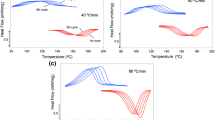Abstract
The interfacial quality of shape memory alloy (SMA) composites was experimentally evaluated by differential scanning calorimetry, and quantitatively calculated using a combination of Šittner's model and a composite cylinder model. Results have shown that the damage level of the interface in a heating process can be quantitatively evaluated by measuring the transformation enthalpy of the subsequent heating cycle and comparing it with the S-shaped enthalpy kinetic curve. A combination of Šittner's model and a composite cylinder model is capable of calculating both the thermal behavior and the triaxial stress state of SMA composites.
Similar content being viewed by others
References
Furuya, Y., Sasaki, A., andTaya, M., “Enhanced Mechanical Properties of TiNi Shape-memory Fiber/Al Matrix Composite,”Mater. Trans. JIM,34,224 (1993).
Armstrong, W.D. andKino, H., “Martensitic Transformations in a NiTi Fiber Reinforced 6061 Aluminum Matrix Composite,”J. Intell. Mater. Syst. Struct.,6,809 (1995).
Rogers, C.A., Liang, C., andJia, J., “Structural Modification of Simply-supported Laminated Plates Using Embedded Shape Memory Alloy Fibers,”Comput. Struct.,38,569 (1991).
Hebda, D.A., Whitlock, M.E., Ditman, J.B., andWhite, S.R., “Manufacturing of Adaptive Graphite-epoxy Structures with Embedded Nitinol Wires,”J. Intell. Mater. Syst. Struct.,6,220 (1995).
Baz, A. andRo, J., “Optimal Vibration Control of Nitinol-Reinforced Composites,”Compos. Eng.,4,567 (1994).
Gabry, B., Thiebaud, F., andLexcellent, C., “Topographic Study of Shape Memory Alloy Wires Used as Actuators in Smart Materials,”J. Intell. Mater. Syst. Struct.,11,592 (2000).
Jonnalagadda, K., Kline, G.E., andSottos, N.R., “Local Displacements and Load Transfer in Shape Memory Alloy Composites,” EXPERIMENTAL MECHANICS,37,78 (1997).
Brinson, L.C., “One-dimensional Constitutive Behavior of Shape Memory Alloys: Thermomechanical Derivation with Non-Constant Material Functions and Redefined Martensite Internal Variable,”J. Intell. Mater. Syst. Struct.,4,229 (1993).
Zheng, Y.J., Cui, L.S., Zhu, D., andYang, D.Z., “The Constrained Phase Transformation of Prestrained TiNi Fibers Embedded in Metal Matrix Smart Composite,”Mater. Lett.,43,91 (2000).
Stalmans, R., Tsoi, K. andSchrooten, J., “The Transformation Behavior of Shape Memory Wires Embedded in a Composite Matrix,”5th European Conf. on Smart Structures and Materials, P. F. Gobin and C. M. Friend (eds), Proc. SPIE,4073,88 (2000).
Schrooten, J., Tsoi, K.A., Stalmans, R., Zheng, Y.J., andŠittner, P., “Comparison between Generation of Recovery Stresses in Shape Memory Wires and Composites: Theory and Reality,”Smart Materials, A. R. Wilson and H. Asanuma (eds), Proc. SPIE 4234, 114 (2001).
Bidaux, J.-E., Manson, J.-A.E., and Gotthardt, R., “Dynamic Mechanical Properties and Phase Transformation in Polymer Based Shape-Memory-Alloy Composites,” Proc. 1st Int. Conf. on Shape Memory and Superelastic Technologies, A. R. Pelton, D. Hodgson and T. Duerig (eds), 37 (1994).
Brinson, L. C. andHuang, M.S., “Simplifications and Comparisons of Shape Memory Alloy Constitutive Models,”J. Intell. Mater. Syst. Struct.,7,108 (1996).
Prahlad, H., andChopra, I., “Comparative Evaluation of Shape Memory Alloy Constitutive Models with Experimental Data,”J. Intell. Mater. Syst. Struct.,12,383 (2001).
Šittner, P., Stalmans, R., andTokuda, M., “An Algorithm for Prediction of the Hysteretic Responses of Shape Memory Alloys,”Smart Mater. Struct.,9,1 (2000).
Vokoun, D. andStalmans, R., “Recovery Stresses Generated by NiTi Shape Memory Wires,”Proc. SPIE,3667,825 (1999).
Abedian, A., Yannacopoulos S., andSzyszkowski, W., “Effects of Free Surface Geometry on the Damage Initiation in Unidirectional Composites Due to Temperature Cycling: An Experimental Investigation,”Can. Metall. Q.,39,99 (2000).
Gdoutos, E.E., Karalekas, D., andDaniel, I.M., “Thermal Stress Analysis of a Silicon Carbide/Aluminum Composite,” EXPERIMENTAL MECHANICS,31,202 (1991).
Author information
Authors and Affiliations
Rights and permissions
About this article
Cite this article
Zheng, Y.J., Schrooten, J., Tsoi, K.A. et al. Qualitative and quantitative evaluation of the interface in activated shape memory alloy composites. Experimental Mechanics 43, 194–200 (2003). https://doi.org/10.1007/BF02410500
Received:
Revised:
Issue Date:
DOI: https://doi.org/10.1007/BF02410500



